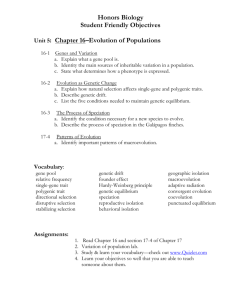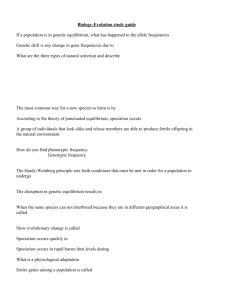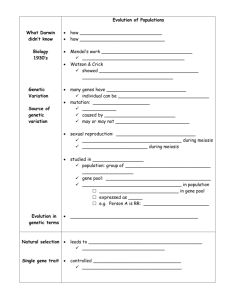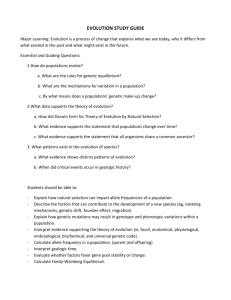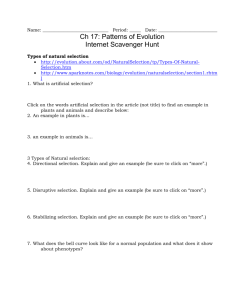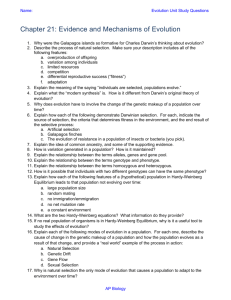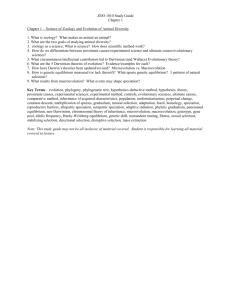Chapter 16 PPT
advertisement
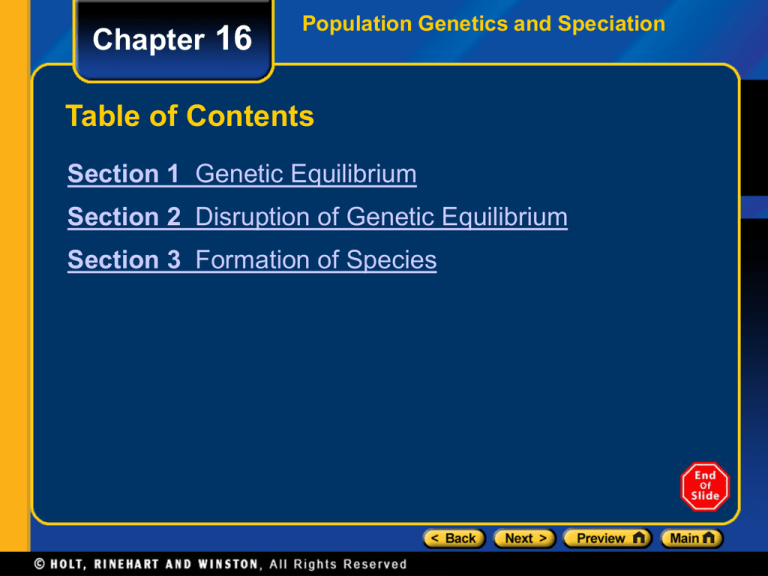
Chapter 16 Population Genetics and Speciation Table of Contents Section 1 Genetic Equilibrium Section 2 Disruption of Genetic Equilibrium Section 3 Formation of Species Chapter 16 Section 1 Genetic Equilibrium Objectives • Identify traits that vary in populations and that may be studied. • Explain the importance of the bell curve to population genetics. • Compare three causes of genetic variation in a population. • Calculate allele frequency and phenotype frequency. • Explain Hardy-Weinberg genetic equilibrium. Chapter 16 Section 1 Genetic Equilibrium Variation of Traits Within a Population • Population biologists study many different traits in populations, such as size and color. Chapter 16 Section 1 Genetic Equilibrium Variation of Traits Within a Population, continued • Causes of Variation – Traits vary and can be mapped along a bell curve, which shows that most individuals have average traits, whereas a few individuals have extreme traits. – Variations in genotype arise by mutation, recombination, and the random pairing of gametes. Chapter 16 Section 1 Genetic Equilibrium The Gene Pool • The total genetic information available in a population is called the gene pool. Chapter 16 Section 1 Genetic Equilibrium The Gene Pool, continued • Allele frequency is determined by dividing the total number of a certain allele by the total number of alleles of all types in the population. Chapter 16 Section 1 Genetic Equilibrium The Gene Pool, continued • Predicting Phenotype – Phenotype frequency is equal to the number of individuals with a particular phenotype divided by the total number of individuals in the population. Chapter 16 Section 1 Genetic Equilibrium The Hardy-Weinberg Genetic Equilibrium • Allele frequencies in the gene pool do not change unless acted upon by certain forces. • Hardy-Weinberg genetic equilibrium is a theoretical model of a population in which no evolution occurs and the gene pool of the population is stable. Chapter 16 Section 1 Genetic Equilibrium Phenotype Frequency Chapter 16 Section 2 Disruption of Genetic Equilibrium Objectives • List five conditions under which evolution may take place. • Explain how migration can affect the genetics of populations. • Explain how genetic drift can affect populations of different sizes. • Contrast the effects of stabilizing selection, directional selection, and disruptive selection on populations over time. • Identify examples of nonrandom mating. Chapter 16 Section 2 Disruption of Genetic Equilibrium Mutation • Evolution may take place when populations are subject to genetic mutations, gene flow, genetic drift, nonrandom mating, or natural selection. • Mutations are changes in the DNA. Chapter 16 Section 2 Disruption of Genetic Equilibrium Gene Flow • Emigration and immigration cause gene flow between populations and can thus affect gene frequencies. Chapter 16 Section 2 Disruption of Genetic Equilibrium Genetic Drift • Genetic drift is a change in allele frequencies due to random events. • Genetic drift operates most strongly in small populations. Chapter 16 Section 2 Disruption of Genetic Equilibrium Nonrandom Mating • Mating is nonrandom whenever individuals may choose partners. Chapter 16 Section 2 Disruption of Genetic Equilibrium Nonrandom Mating, continued • Sexual Selection – Sexual selection occurs when certain traits increase an individual’s success at mating. – Sexual selection explains the development of traits that improve reproductive success but that may harm the individual. Chapter 16 Section 2 Disruption of Genetic Equilibrium Natural Selection • Natural selection can influence evolution in one of three general patterns. Chapter 16 Section 2 Disruption of Genetic Equilibrium Natural Selection, continued • Stabilizing Selection – Stabilizing selection favors the formation of average traits. Chapter 16 Section 2 Disruption of Genetic Equilibrium Natural Selection, continued • Disruptive Selection – Disruptive selection favors extreme traits rather than average traits. Chapter 16 Section 2 Disruption of Genetic Equilibrium Natural Selection, continued • Directional Selection – Directional selection favors the formation of more-extreme traits. Chapter 16 Two Kinds of Selection Section 2 Disruption of Genetic Equilibrium Chapter 16 Section 3 Formation of Species Objectives • Relate the biological species concept to the modern definition of species. • Explain how the isolation of populations can lead to speciation. • Compare two kinds of isolation and the pattern of speciation associated with each. • Contrast the model of punctuated equilibrium with the model of gradual change. Chapter 16 Section 3 Formation of Species The Concept of Species • According to the biological species concept, a species is a population of organisms that can successfully interbreed but cannot breed with other groups. Chapter 16 Section 3 Formation of Species Isolation and Speciation • Geographic Isolation – Geographic isolation results from the separation of population subgroups by geographic barriers. Chapter 16 Section 3 Formation of Species Geographic Isolation Click below to watch the Visual Concept. Visual Concept Chapter 16 Section 3 Formation of Species Isolation and Speciation, continued • Allopatric Speciation – Geographic isolation may lead to allopatric speciation. Chapter 16 Section 3 Formation of Species Isolation and Speciation, continued • Reproductive Isolation – Reproductive isolation results from the separation of population subgroups by barriers to successful breeding. Chapter 16 Section 3 Formation of Species Reproductive Isolation Click below to watch the Visual Concept. Visual Concept Chapter 16 Section 3 Formation of Species Isolation and Speciation, continued • Sympatric Speciation – Reproductive isolation within the same geographic area is known as sympatric speciation. Chapter 16 Section 3 Formation of Species Rates of Speciation • In the gradual model of speciation (gradualism), species undergo small changes at a constant rate. • Under punctuated equilibrium, new species arise abruptly, differ greatly from their ancestors, and then change little over long periods. Chapter 16 Section 3 Formation of Species Comparing Punctuated Equilibrium and Gradualism Click below to watch the Visual Concept. Visual Concept
